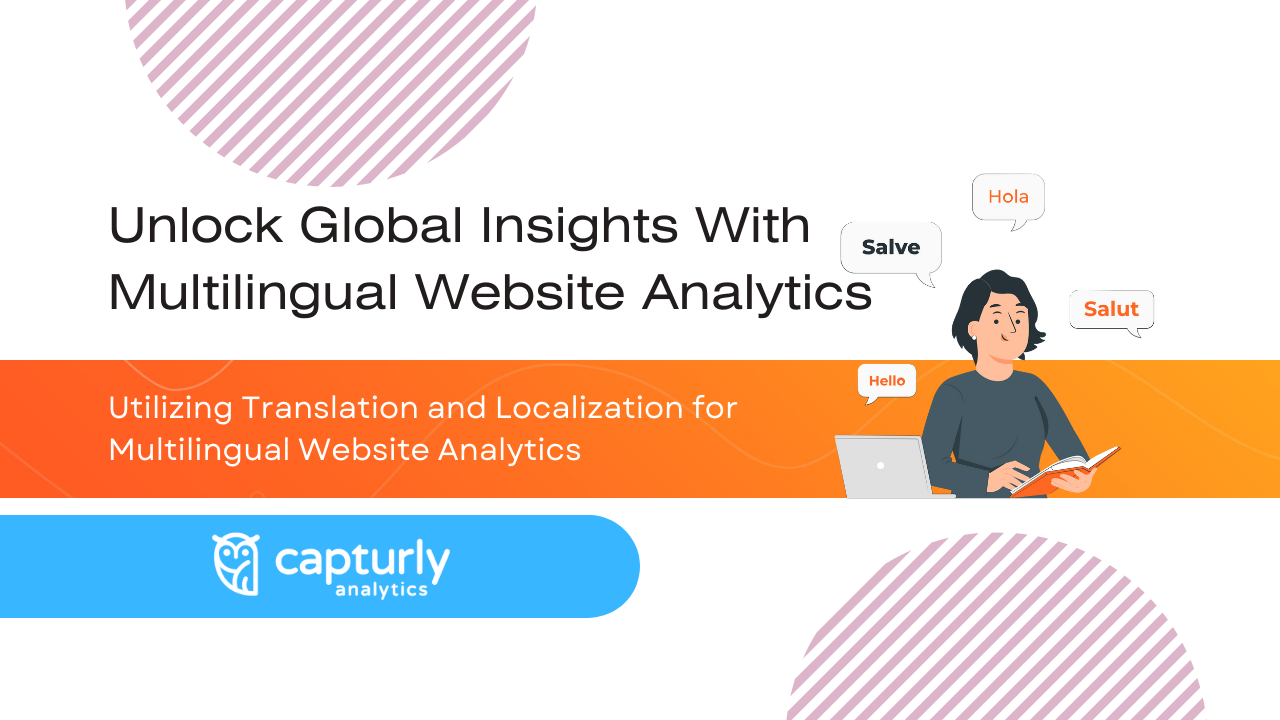In today’s globally interconnected landscape, businesses are not restricted by geographical borders. It’s because the internet and digital tech let companies reach people all around the world. This means it’s really important to know how lots of different people like to do things, to do well in the global marketplace. That’s why understanding the behavior and preferences of a diverse range of users, using tools like multilingual website analytics, has become essential for success.
Multilingual website analytics, powered by translation and localization, is pivotal in unlocking valuable insights. This can drive business growth, and in this article, we will discuss all that and more.
Significance of Multilingual Website Analytics in Today’s Global Market
Multilingual website analytics revolutionize user experience by dissecting data from diverse language users, informing strategic decisions, and fostering deeper connections.
Better User Experience
Multilingual website analytics means collecting, studying, and understanding information from people who use a website in different languages. Lots of internet users like to use their language online, so having a website in many languages is very important. This helps companies learn how people in different language groups use their websites and make smart choices using what they learn.

Enhanced User Connection through Multilingual Websites
A big benefit of having a multilingual website is that it can make users feel more connected and comfortable. When people browse in their own language, they tend to stay on the website longer, look at everything closely, and talk or do things that matter. This helps them feel good and connected.
Cultivating Deeper Connections
When a website is in many languages, it can help people feel a stronger connection. People feel more relaxed and linked when they explore in their own language. So, they might spend more time on the website, look at things more closely, and interact in meaningful ways. This is nice for them.
Identifying and Resolving Language-specific Issues
Multilingual website analytics can find problems in different languages on a website. These problems can make it hard for people to use the site easily. When these problems are fixed, the website becomes better for everyone, no matter what language they speak. The analytics can also show how well your marketing is working. They can tell you which language content is doing well and make more people do what you want on the website.
Tailoring Marketing to Language and Culture
Multilingual website analytics helps businesses adjust their marketing to fit different languages and cultures. This makes people feel more connected to the company and helps the company grow. It also helps the company keep customers loyal to its brand.
Overview of Translation and Localization in Website Analytics
Translation and localization are important parts of multilingual website analytics. Translation changes website content from one language to another while keeping it accurate. Localization looks at cultural differences and makes the content fit a specific audience. This makes websites better for people in different places. Businesses use multilingual website analytics to make translation and localization plans. These professional translators improve how people from other countries use the website. It makes their experience better.
The Power of Multilingual Website Analytics
Multilingual website analytics helps businesses understand their worldwide audience better. It looks at how people behave on different language versions of the website. This helps companies find trends, likes, and problems for each group of people.
They can learn about things like how people move around the site, how much time they spend on different pages, and what they do on the site. This information can be used to make special marketing plans and content for each language group.
Data-driven decision-making is crucial for business growth. By harnessing multilingual website analytics, companies can optimize their strategies and improve the user experience. They can align their offerings with the preferences of diverse international audiences
Challenges in Multilingual Website Analytics
You must learn about different challenges in multilingual website analytics before developing any plans or strategies. We have listed below a couple of them, as follows.
Language Barriers and Their Impact on Data Accuracy
Language differences can create obstacles in accurately interpreting user behavior. Literal translations may lead to misunderstandings, affecting the reliability of data analysis.
Cultural Nuances and Contextual Understanding
Cultural nuances influence user preferences and interactions. Understanding these subtleties is vital to make data-driven decisions that resonate with diverse cultures.
Technical Considerations in Multilingual Tracking and Reporting
Implementing multilingual analytics requires technical expertise and the tools to accurately collect, analyze, and report data in multiple languages. One of the primary challenges in multilingual tracking is the diverse range of languages that need to be accounted for.
Each language may have unique character sets, grammar rules, and writing systems, which can pose complexities regarding data processing. Consequently, it becomes essential to employ specialized techniques and algorithms that can handle these language-specific intricacies effectively.
A fundamental requirement in multilingual tracking is the ability to collect data from various sources and in different languages. It necessitates the development of data collection systems that can efficiently aggregate information from diverse linguistic contexts. It may involve integrating language detection mechanisms to identify the language of incoming data and ensure it is appropriately categorized for further analysis.
Adapting Analytical Tools for Multilingual Insights
Keyword research must extend beyond translation. Understanding regional search behaviors and preferences is crucial for successful SEO optimization. Tailoring keywords to specific languages ensures the website’s visibility and improves data collection accuracy.
Utilizing analytics platforms with language-specific capabilities enhances data collection and analysis. Some regions may have unique analytical requirements, and using tools that cater to these specific needs provides more comprehensive insights.
Creating customized dashboards for multilingual reporting allows stakeholders to access data relevant to their target markets. Tailoring data visualization and metrics presentation according to language-specific preferences improves data interpretation and decision-making.
Translating Website Content for Effective Analytics
Effective data collection requires a strategic approach to localization. Adapting website content to suit different cultures, languages, and regional preferences is crucial. A key strategy is employing localization experts who understand cultural nuances and can tailor content to resonate with specific audiences. Additionally, considering local holidays, customs, and terminologies enhances data accuracy.
Key Performance Indicators (KPIs) need to stay important and meaningful in every language. This is necessary for good business choices. Using experts who speak the language can help find cultural differences. This makes KPIs better for reporting in different languages.
Translation consistency is critical to maintaining a unified brand image and facilitating comparative analytics. Employing translation glossaries and style guides ensures linguistic harmony across various language versions. Regularly reviewing translated content for quality and relevance guarantees accurate data for analytics.
Adapting Analytical Tools for Multilingual Insights
Keyword research must extend beyond translation. Understanding regional search behaviors and preferences is crucial for successful SEO optimization. Tailoring keywords to specific languages ensures the website’s visibility and improves data collection accuracy.
Utilizing analytics platforms with language-specific capabilities enhances data collection and analysis. Some regions may have unique analytical requirements, and using tools that cater to these specific needs provides more comprehensive insights.
Creating customized dashboards for multilingual reporting allows stakeholders to access data relevant to their target markets. Tailoring data visualization and metrics presentation according to language-specific preferences improves data interpretation and decision-making.
Cross-Cultural Data Interpretation and Analysis
Metrics must be interpreted with cultural context in mind. Cultural differences can significantly impact user behavior and preferences. Understanding these nuances allows analysts to derive more meaningful insights from data.
Interpreting Multilingual Conversion Rates and User Engagement
Analyzing conversion rates and user engagement across languages enables identifying high-performing markets and areas for improvement. Identifying cultural factors influencing user behavior helps optimize website content and user experience.
A/B testing in different languages provides insights into what resonates best with specific audiences. Understanding the variations in test results across languages helps refine website content and conversion strategies.
Multilingual User Experience (UX) Optimization
Intuitive navigation and layout are crucial for delivering a seamless user experience. Adapting these elements to suit different languages ensures ease of use and boosts user engagement.
Multilingual usability testing uncovers language-specific usability issues. Gathering user feedback in different regions helps refine the website’s UX and improves data collection.
Heatmaps and clickstream analysis reveal user behavior patterns. Applying these analytical methods to different language versions identifies user preferences and pain points, leading to targeted improvements.

Machine Translation and Natural Language Processing
Machine translation can expedite the translation process for real-time analytics. Integrating machine translation tools with analytical platforms enables prompt data analysis for multiple languages.
While machine translation offers speed and cost-efficiency, it may not capture cultural nuances accurately. Understanding the strengths and limitations of machine translation helps make informed decisions about its use in analytics.
NLP can extract valuable insights from multilingual user feedback and comments. Sentiment analysis and text mining provide a deeper understanding of customer perceptions across various language segments.
Addressing Privacy and Data Protection
Collecting and handling data from different regions require adherence to various data privacy regulations. Ensuring compliance with GDPR, CCPA, and other applicable laws protects user data and maintains trust.
Anonymizing data and obtaining consent for data collection are essential steps in multilingual analytics. By doing this, you are respecting user privacy while collecting data, allowing more reliable and ethical insights.
Implementing robust data security measures safeguards sensitive information during multilingual tracking and analysis. Employing encryption and secure storage ensures data protection and integrity.
The Role of Multilingual Content Personalization
Personalizing content based on language preferences enhances user engagement and satisfaction. Delivering relevant content in the user’s preferred language fosters a stronger connection with the brand.
Analyzing user behavior across languages enables targeted content recommendations. Tailoring content based on language-specific interests and preferences increases the chances of conversion.
Implementing dynamic content translation allows real-time content updates across different language versions. This approach ensures that users receive the latest information, contributing to a positive user experience.
Measuring Return on Investment (ROI) in Multilingual Analytics
Measuring the ROI from different language segments enables businesses to identify lucrative markets. Comparing investments and returns across languages helps allocate resources effectively.
Assessing revenue generation and conversion rates by language helps optimize marketing and sales strategies. Identifying high-converting languages enables targeted efforts to drive revenue growth.
Setting performance benchmarks allows businesses to measure success over time. Benchmarking facilitates continuous improvement and goal-oriented decision-making.
Summary
We highlighted the importance of translation and localization to use website analytics effectively. Translation and localization are not just about making content accessible in different languages. They are integral to understanding diverse markets, engaging with users effectively, and gathering accurate data for insightful analytics.
We talked about using various languages for good data. Changing tools to understand different languages and cultures is important. Making websites better was also discussed. Keeping data safe and creating special content in different languages were important points. We also considered whether using different languages gives more than what was spent. We think this article will help you when you start to make your website bigger by looking at how people use it in different languages.
Don't forget, sharing is caring! :)






2 Comments
fall guys
2024-01-17 at 05:13I earnestly anticipate a substantial increase in content of a similar nature. I appreciate your willingness to share your information with me. I have bookmarked your blog due to the discovery of highly valuable material on it.
fireboy and watergirl
2024-01-17 at 05:14This paper was quite fascinating and educational, in my opinion. We appreciate you sharing your unique opinions with us. I most definitely tell my friends about this.